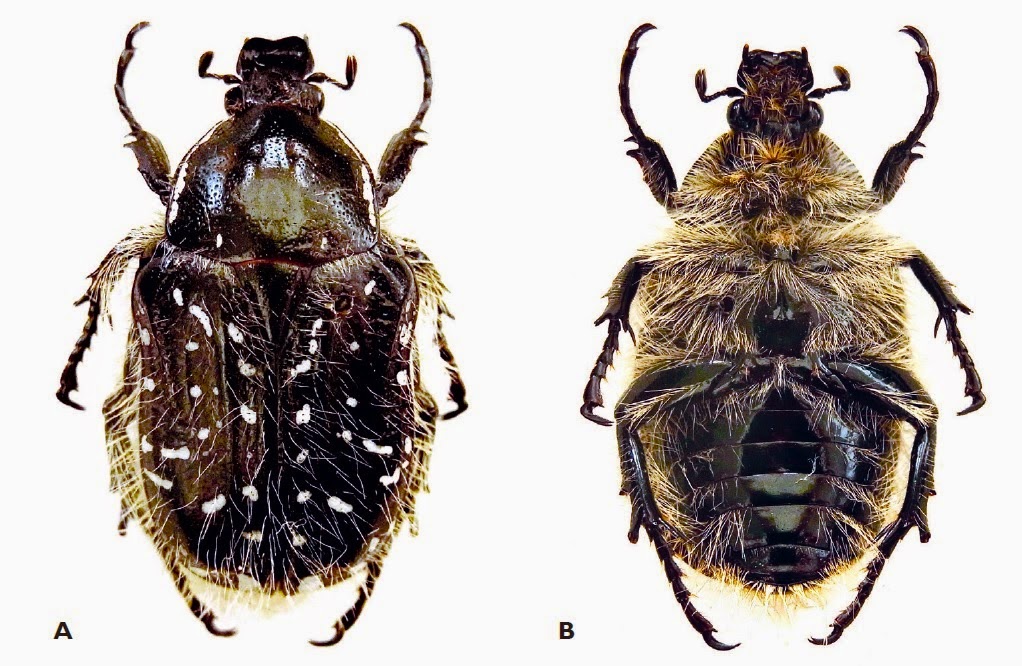Beetles first appear in the fossil record in the Early Permian. And
by the Triassic were already beginning to dominate Insect faunas, with many
modern groups in existence by the end of the Cretaceous. However the majority
of Beetle groups were defined from extant species, and many are hard to
differentiate in the fossil record because of this, with the result that many
fossil Beetle groups are not well studied, and fossil collections in museums
and universities often include many undescribed Beetles.
In a paper published in the journal Acta Palaeontologica Polonica on
9 August 2013, Carmen Soriano of the European Synchrotron Radiation Facility, DarrenPollock of the Department of Biology at Eastern New Mexico University, Didier
Néraudaeu of Géosciences Rennes and the Centre national de la recherche scientifique, Andre Nel of the MuséumNational d’Histoire Naturelle and Paul Tafforeau, also of the European
Synchrotron Radiation Facility, describe a Polypore Fungus Beetle from Early
Cretaceous Amber from Archingeay-Les Nouillers in the Charente-Maritime
Department in southwest France.
The amber is opaque, as is the majority of amber from the Early
Cretaceous of France (and Mesozoic amber in general). However it has proven
possible to build up three-dimensional models of Insects trapped in such amber
using X-ray synchrotron microtomography. This method enables the fossil to be
examined at any angle desired, and even for internal features, not usually
available to palaeoentomologists, to be examined.
The new Beetle is named Synchrotronia
idinineteena, where ‘Synchrotronia’
refers to the European Synchrotron Radiation Facility in Grenoble, where the
specimen was detected and reconstructed, and ‘idinineteena’ refers to the beamline in which the specimen was
detected and imaged (ID19). It is a 3.2 mm long, 1.4 mm wide Beetle with a
narrow head and lateral eyes close to the antennae. Based upon careful
examination of the limbs of the specimen it was possible to place it within the
Tribe Holostrophini, which is in the Subfamily Eustrophinae of the Family
Tetratomidae (Polypore Fungus Beetles). This is not only the oldest known
member of the Family Tetratomidae, it is the first Mesozoic fossil to be
assigned to the group at all.
3D reconstruction of the holotype of Synchrotronia idinantinensis. Specimen tomographied
in beamline ID19 of the ESRF, at 30keV and 5.06 μ voxel size. Scale bar 2 mm.
Soraino et al. 2014.
In modern times the Tribe Holostrophini is largely restricted to
north and east Asia, with only a single species found in Europe. The Beetles
feed on wood rotting Fungi, which would be a plausible diet for a Cretaceous
Beetle found in amber (which is preserved tree resin). The specimen is about
140 million years old, dating to a time when the climate was extremely warm,
and the amber is believed to have been produced by a Gymnosperm tree living in
a warm, humid, estuarine forest.
See also…
There are currently eight species of Scarab
Beetles in the genus Scapanoclypeus,
which is known from Namibia and western South Africa. They are placed within a
group of Tanyproctine Scarabs which are found only in Africa.
 A new species of Scarab Beetle from the Elandsberg Mountains of the Western Cape, South Africa. Scarab Beetles of the genus Trichostetha occur across southern Africa, reaching their greatest diversity in...
A new species of Scarab Beetle from the Elandsberg Mountains of the Western Cape, South Africa. Scarab Beetles of the genus Trichostetha occur across southern Africa, reaching their greatest diversity in...
 A Pine Cone Weevil from Cretaceous Burmese amber. Pine Cone Weevils (Nemonychidae) are thought likely to be the oldest
group of surviving Weevils (Curculionoidea), making their understanding
their evolution important for...
A Pine Cone Weevil from Cretaceous Burmese amber. Pine Cone Weevils (Nemonychidae) are thought likely to be the oldest
group of surviving Weevils (Curculionoidea), making their understanding
their evolution important for...
 A new species of Scarab Beetle from the Elandsberg Mountains of the Western Cape, South Africa. Scarab Beetles of the genus Trichostetha occur across southern Africa, reaching their greatest diversity in...
A new species of Scarab Beetle from the Elandsberg Mountains of the Western Cape, South Africa. Scarab Beetles of the genus Trichostetha occur across southern Africa, reaching their greatest diversity in... A Pine Cone Weevil from Cretaceous Burmese amber. Pine Cone Weevils (Nemonychidae) are thought likely to be the oldest
group of surviving Weevils (Curculionoidea), making their understanding
their evolution important for...
A Pine Cone Weevil from Cretaceous Burmese amber. Pine Cone Weevils (Nemonychidae) are thought likely to be the oldest
group of surviving Weevils (Curculionoidea), making their understanding
their evolution important for...
Follow Sciency Thoughts on Facebook.


